Lisa Baumgarten
Critical design mediation – Kritische Designvermittlung
⤻ Design ⤻ Research/Writing ⤻ Education/Workshops ⤻ Curation

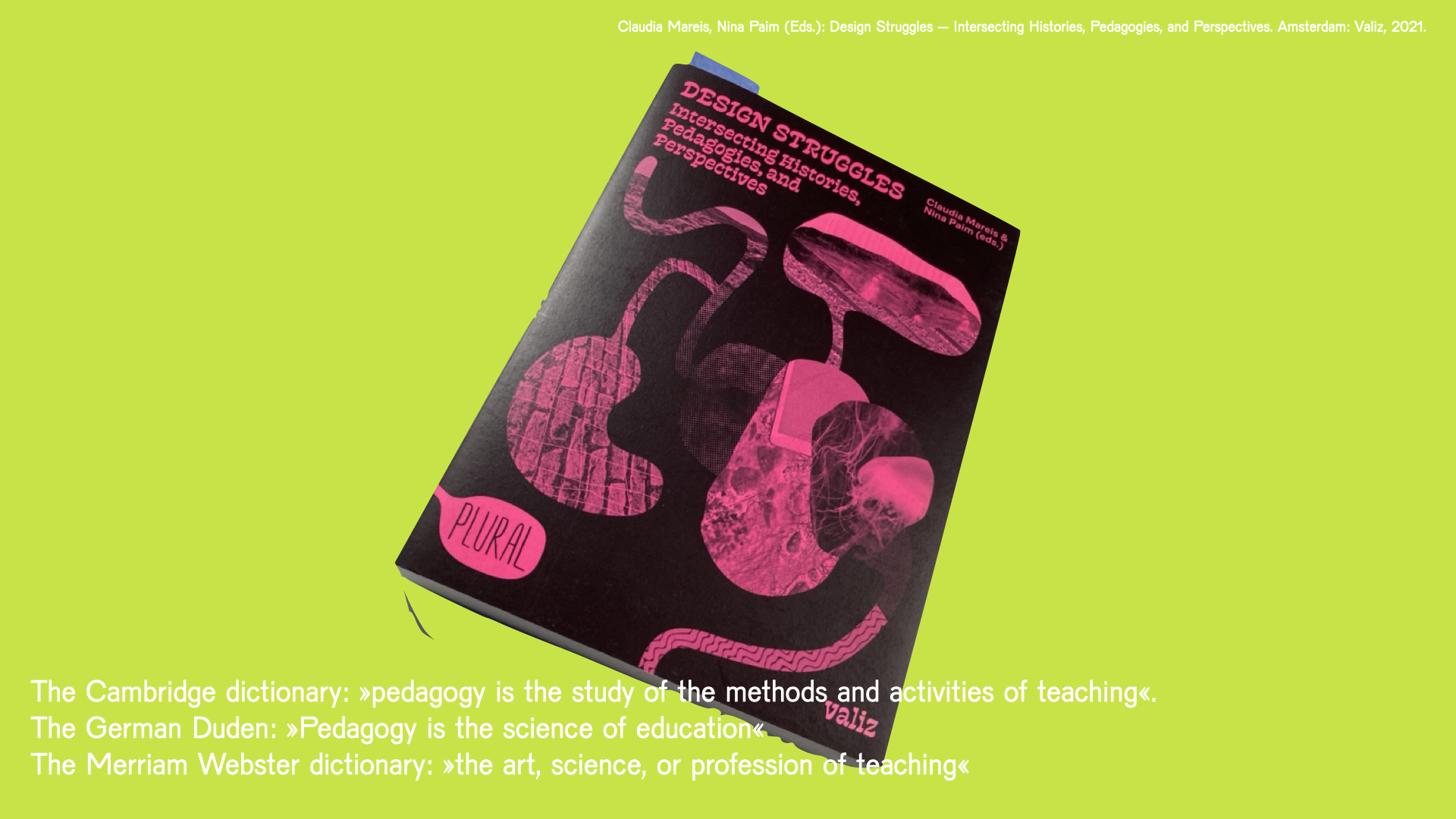

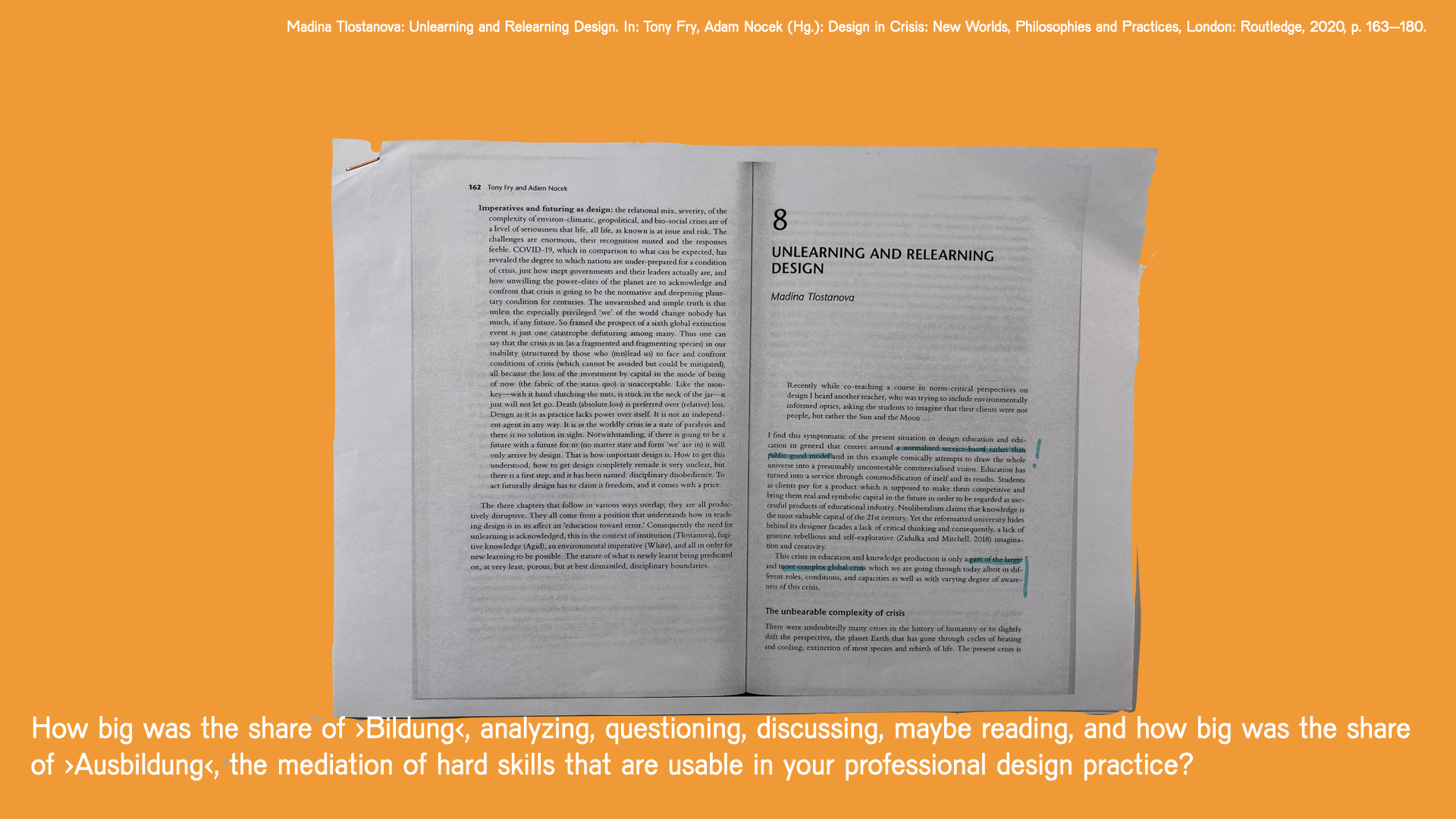

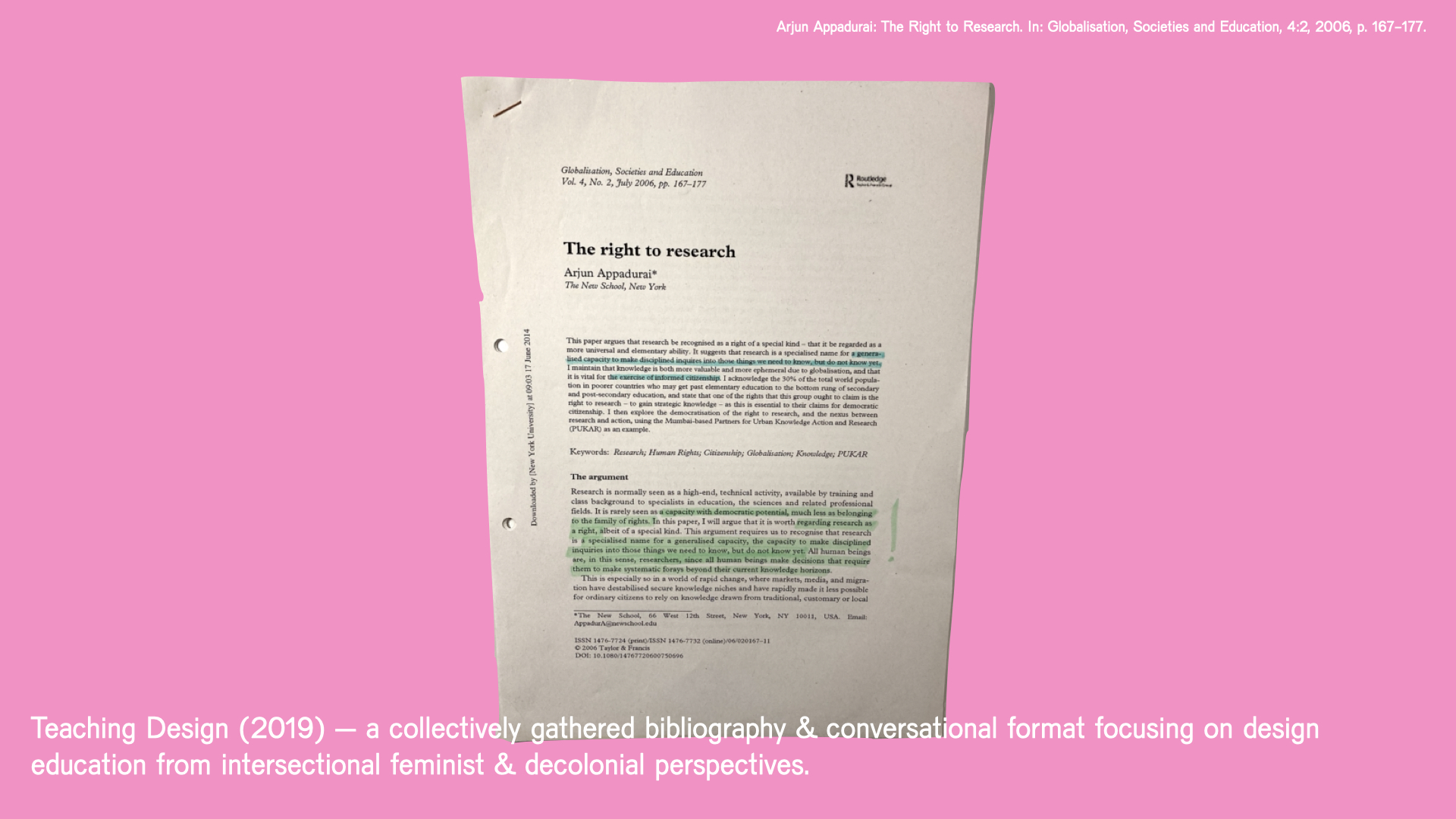

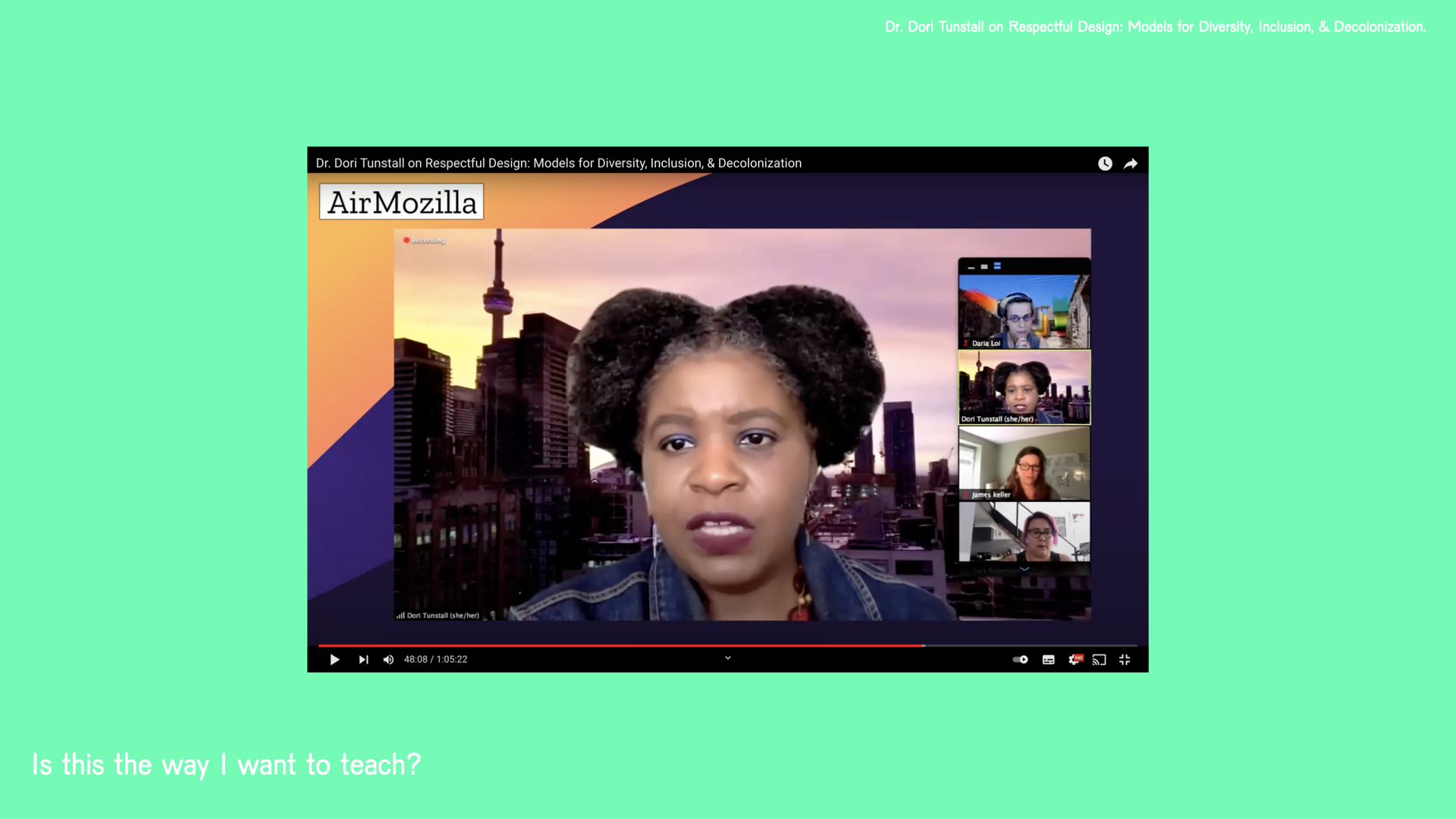
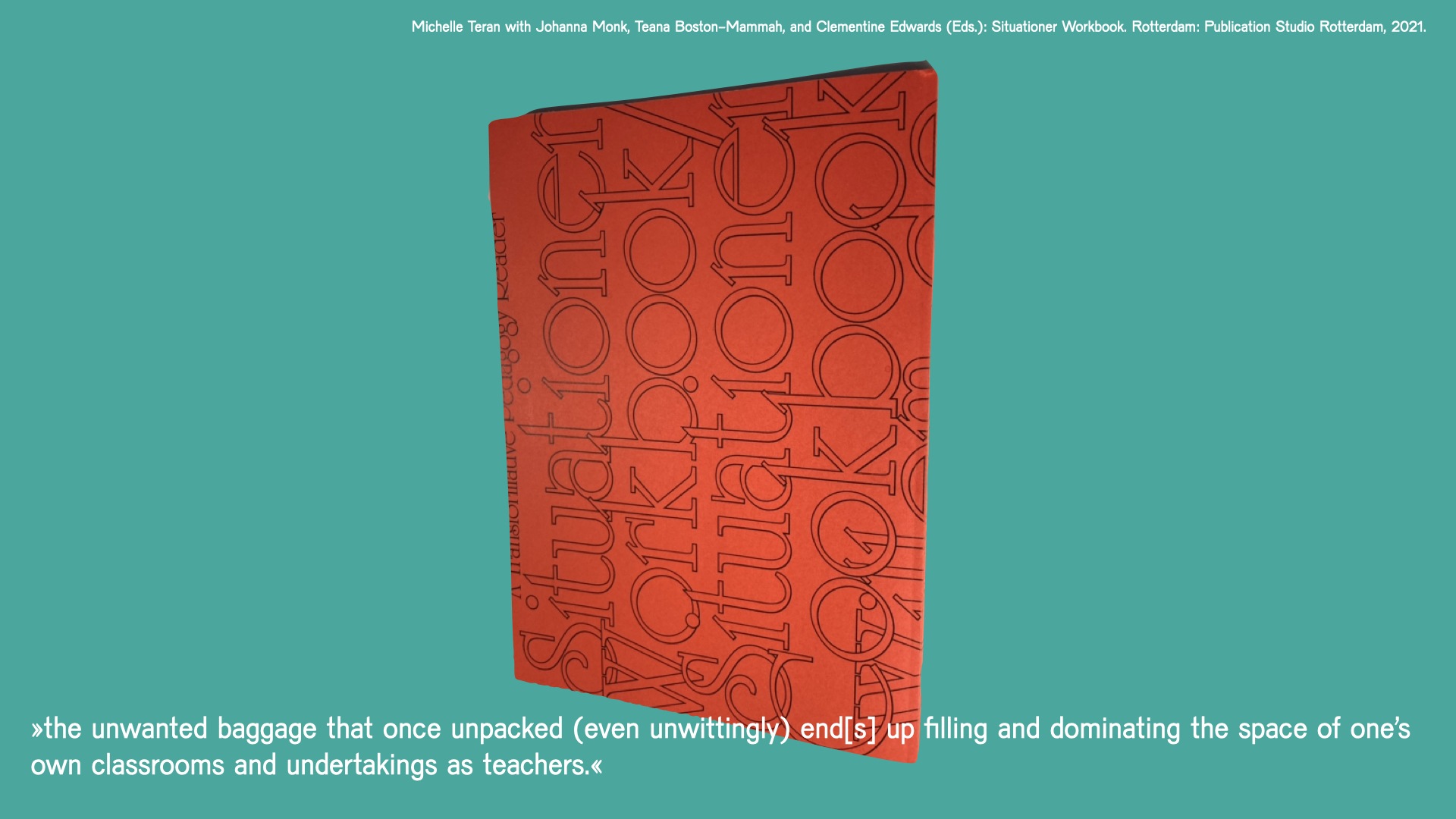
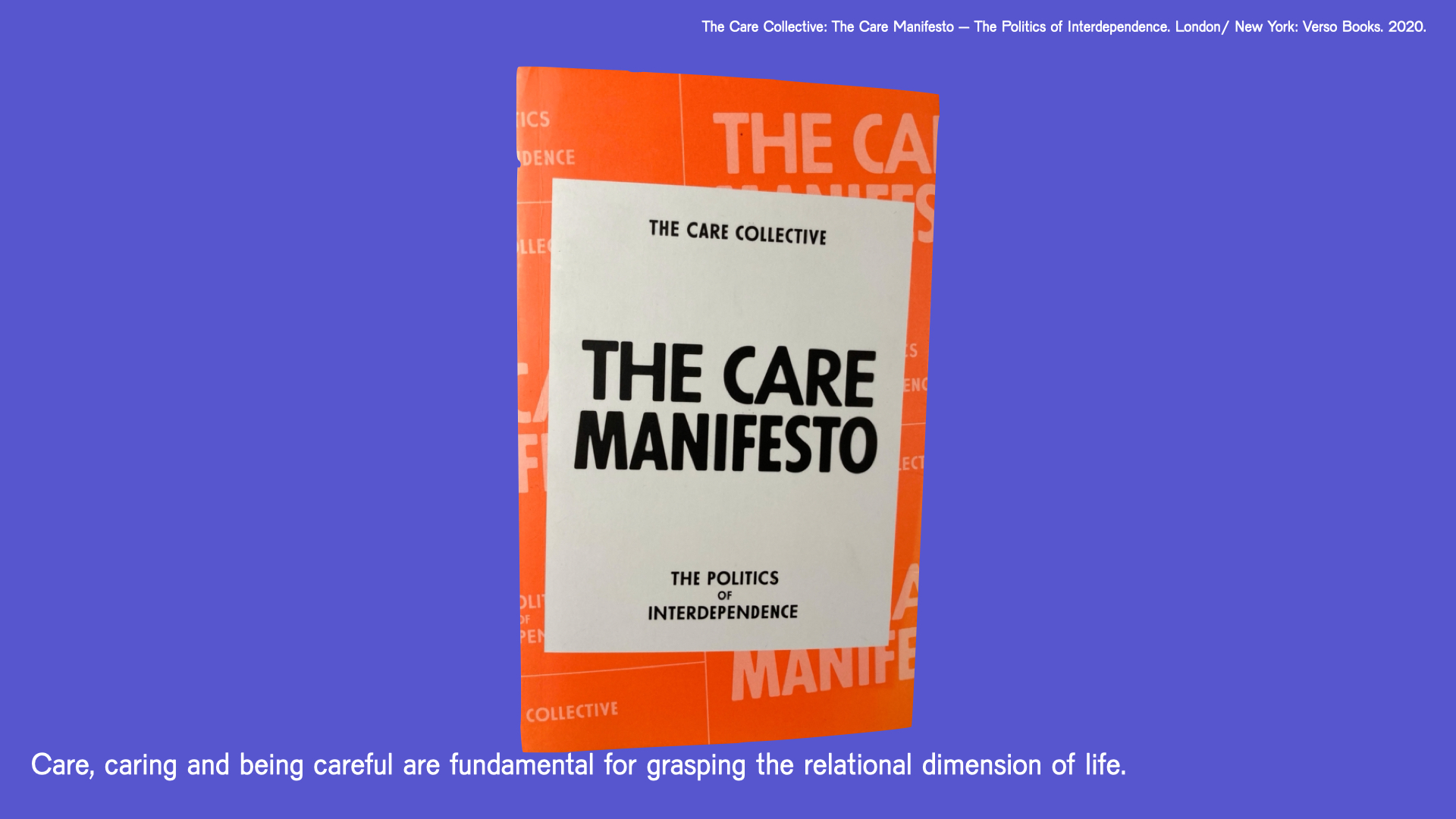













I’ve been thinking quite a bit about the term ›pedagogy‹ …
Design X Teaching with Lisa Baumgarten and Alice TwemlowDesign Museum Gent, 25.11.2021
I’ve been thinking quite a bit about the term ›pedagogy‹ and what that means in the context of design. There has been a lot of talk about design influencing our present and future, but how do we learn to design? How are we taught to be designers within the current framework of institutionalized design education? And how does this influence the way we inhabit the world, perceive the world, or feel empowered to transform the world?
During my talk, which will be around 20 mins, I will show publications – uncommented as sort of a backdrop – that have informed my thinking about these questions, guided me in difficult situations but also challenged me and led to even more questions. Sometimes they are directly related to what I am saying and sometimes not.
Assumptions on ›pedagogy‹
The longer I teach design in higher education, the less certain I am of the answers to these questions and the more I realize that I’ve always worked from assumptions. If someone were to ask me to make a statement about what design pedagogy is, I would probably be able to come up with something. I believe this is true for most of us. Despite our assumptions, I think we can all agree design pedagogy has something to do with education. Just so we’re all on the same page—I looked up the definition of pedagogy for you:
The Cambridge dictionary states: »pedagogy is the study of the methods and activities of teaching«. The German Duden states: »Pedagogy is the science of education« and the Merriam Webster dictionary defines pedagogy as »the art, science, or profession of teaching«.
Ok, so we know that pedagogy is a scientific discipline that is concerned with the theory and practice of education. And we know that a pedagogue is someone who is professionally concerned with the practice and theory of education. The profession of teacher/educator falls within the category of pedagogy. How many design teachers do you know who are professionally concerned with the practice and theory of education?
Education and Bildung
Let me pin down what I am talking about when I refer to »education«. I am not familiar with the terms used in French or Dutch, but »education« can be translated into German as two different terms which have distinct meanings and come from different discourses.
Educational scientist Ece Kaya refers to two concepts: education in the sense of ›Ausbildung‹, which means vocational education. ›Ausbildung‹ is about learning skills and tools which are purpose-directed, and is associated with the German term ›Erziehung‹ which means shaping someone according to a plan by force.
Then, there is education in the sense of ›Bildung‹, which implies a transformative potential, a liberating act of becoming conscious. Unlike Ausbildung, or vocational education, Bildung has revolutionary potential, is attributed a critical-analytical mindset, an emancipatory aspiration, and is seen as a continuous process that goes on after school is finished. Vocational education traditionally takes place in companies and training institutions, whereas Bildung is associated with schools, universities or higher education institutions. Pivoting to what that means in the context of design, if you think about your design education: How big was the share of ›Bildung‹, analyzing, questioning, discussing, maybe reading, and how big was the share of ›Ausbildung‹, the mediation of hard skills that are usable in your professional design practice? My impression is that this differs from one institution to another, as well as from one educator to another.
Practitioner = Teacher?
This brings me to my role as a teacher, how I came to teaching and also the question of what qualifies me to be a teacher. While I was working as a designer, I had coffee with an individual who needed someone to teach a seminar on typography. I had facilitated some workshops before, and I was interested in mediation, so I accepted the offer. In order to be hired as an adjunct lecturer, I was only required to submit my CV and a copy of my diploma. No one wanted to know about my teaching experience or pedagogical skills. For the design educators here tonight this probably isn’t surprising – it is common practice. But does my expertise as a designer prepare me to be a good educator? I would say no. From the research I have conducted through my platform Teaching Design, through numerous conversations and my own experiences, almost everyone transitioning from design practice to teaching said it was mostly learning by doing. Looking back at the first two seminars I offered, I would say I wasn’t a very good design pedagogue. I didn’t know how to structure a seminar, I didn’t know how to ›create a space‹, I was unsure about how to come up with exercises to mediate a specific topic or issue, I didn’t know how much I should let the students be involved in directing the seminar … but I did know how to give feedback – These are just some examples … so for the most part, I was clueless.
Where is the pedagogy in design?
This cluelessness was the reason I started the platform Teaching Design in 2019. The starting point was to gather a body of texts that deal with design education from intersectional-feminist and decolonial perspectives, which at the time weren’t abundant.
Talking to other educators in the field made me realize I wasn’t alone in feeling lost. Some had more experience than others, but we all were, and still are, doing our own thing. Design education seems very individualistic. At the time – and this question still lives with me – I was asking myself: Why do these individuals/ educators seem to communicate so little with each other about their ways of teaching? It felt a bit like starting from scratch. The concepts that were easily accessible – which is usually the case with canonical texts/ concepts – weren’t addressing questions that I was and am still most concerned with. Questions of normalisation and equality and of power structures, colonial histories, privilege, and the intersections of oppression.
At the same time, designers who become educators have all been through the bottleneck of design education before – something you intuitively draw from when you start teaching design. Until I started teaching, I had never wondered why my design teachers taught the way they did, not differently. I never wondered: who were they influenced by? So even though I felt like my teaching was non-referential, now I know that the way I learned design was strongly influenced by interpretations of the Bauhaus and HFG Ulm. Without much reflection on my part, this foundation shaped my approach to teaching. But is this the way I want to teach? This dilemma is what activist, researcher and educator Michelle Teran calls »the unwanted baggage that once unpacked (even unwittingly) end[s] up filling and dominating the space of one’s own classrooms and undertakings as teachers.«
And if there were a single design pedagogy embedded in the current neoliberal notion of education, wouldn’t that imply some sort of systematization and standardization, even parametrization? Could a single design pedagogy be enough for the plurality of lived realities humans bring into teaching-/learning spaces?
As I said, We are not speaking about design pedagogy enough. Not only the „how“ we teach but also how this »how« came to be. For the critical pedagogue Paolo Freire – and I am quoting Michelle Teran again – »curricular content and educational setting must be intimately linked with an overall plan for society. Education must not be made for the people, but with the people […]. Education is a form of world building.«
So going back to my initial question: How is design education shaping our ways of being in the world? And why is it important to think about and discuss?
How can this be put into practice?
As I previously said, most trained designers go through the bottleneck of design education. I believe that institutionalized design education is decisive for the practical and discursive development of the field. As Colombian-American anthropologist Arturo Escobar's states, looking at design through an ontological lense, it is decisive for shaping our present and future.
The philosopher Anne-Marie Willis sums up the concept of ontological design beautifully when she writes: »we design our world, while our world acts back on us and designs us.«
This clarifies the political implications of the ontological dimension of design. At the same time, it broadens the meaning of design. Linked to the value system of modernity and developed within patriarchal structures, design is inextricable from the creation and reproduction of power relations. Colonialism, and thus also racism, are significant constituents of this development, as decolonial queer feminist design theoriest Ece Canli argues.
According to Escobar the current »interrelated crises of climate, food, energy, poverty and meaning« of our contemporary world, can be traced back to a »massive design failure«.
We design our world, while our world acts back on us and designs us. So far this has been happening in a destructive, careless way. As Escobar shows, we can only care for the world if we can relate to the world. However, in order to relate to the world, we need to feel like the world concerns us, as sociologist Hartmut Rosa points out, we need to feel »resonance«. It is through this resonance that one is able to truly encounter the world, experience and feel alive within it. A resonating relationship with the world can be made possible by— or be obstructed by—education.
Care, caring and being careful are fundamental for grasping the relational dimension of life. Furthermore, care is indispensable for academic learning and teaching, at least if we understand universities as places of work with and for people, for which relationality is constitutive and decisive. As feminist sociologist Raewyn Connell states, care is an intrinsic part of teaching, which can only happen if there is space for ›encounter‹.
»Education involves encounter between persons, and that encounter involves care. Learning from a computer is not education; the machine does not care. Learning from a person behaving like a machine is not education; that person’s capacity for care is being suppressed. It is care that is the basis of the creativity in teaching, at all levels from Kindergarten to PhD supervision, as the teacher’s practice evolves in response to the learner’s development and needs.«
And as we’ve all experienced, ›encounter‹ has become limited in the past 1.5 years. Resonance requires encounter and experience, being in touch with oneself, each other and the world in order to feel empowered and to feel agency for transformative (design) practices.
Through the Teaching Design platform and my own teaching practice, I’ve learned a lot: multiple narratives of the genealogy of design, the power structures design is entangled in, and the power relations it reproduces. I learned about the different positions within hierarchies in the classroom – different takes on the relationship between teacher and learner. About different ways of knowing and producing knowledge. And I learned about the destructive but also transformative potential of design. Most importantly I learned that I am not the only one thinking about this… In the past years a multitude of formats, writings and publications have contributed meaningfully to the discourse around design education – I’ve mentioned a few of them throughout this lecture.
But circling back to the beginning again:
According to Rosa, a healthy relationship to the world can be made possible by or be obstructed by education. The critical art mediator Nora Sternfeld writes that places of teaching and learning hold the potential to open up worlds or to close them off.
So what kind of design pedagogy derives from this awareness? How can we open up worlds in design education? If design is shaping our world and us – and that has a transformative potential – mustn’t that be part of a design education? Mustn’t design education itself be transformative, careful, relational, resonant? And to finish with a question that I’ve been continuously curious to learn more about: How can this be put into pedagogical practices?
Design Dialogues is an ongoing series of dialogues on design related topics organized by KASK School of Arts Gent and hosted by the Design Museum Gent.
Find more infos on the website of Design Museum Gent.
Or watch the dialogue online on Facebook.
↓
This text is published under the Creative Commons License CC BY-NC-SA: Attribution-NonCommercial-ShareAlike 4.0. As long as attribution is given to the author or copyright holder, this licence allows reusers to copy, distribute, and display or perform the material in public. You may not use the material for commercial purposes. The material may be modified (such as for translations). Modified material must be distributed unter the same license.
Find more infos on the website of Design Museum Gent.
Or watch the dialogue online on Facebook.
↓
This text is published under the Creative Commons License CC BY-NC-SA: Attribution-NonCommercial-ShareAlike 4.0. As long as attribution is given to the author or copyright holder, this licence allows reusers to copy, distribute, and display or perform the material in public. You may not use the material for commercial purposes. The material may be modified (such as for translations). Modified material must be distributed unter the same license.